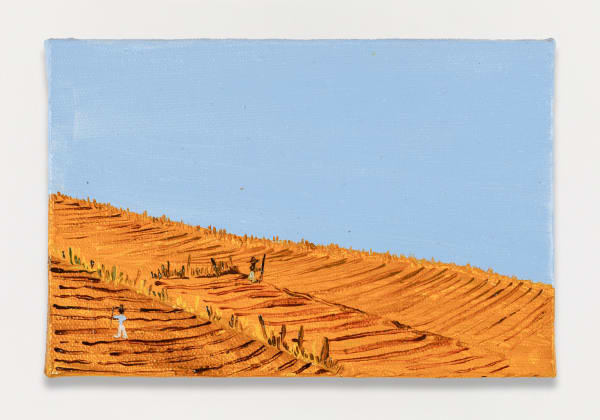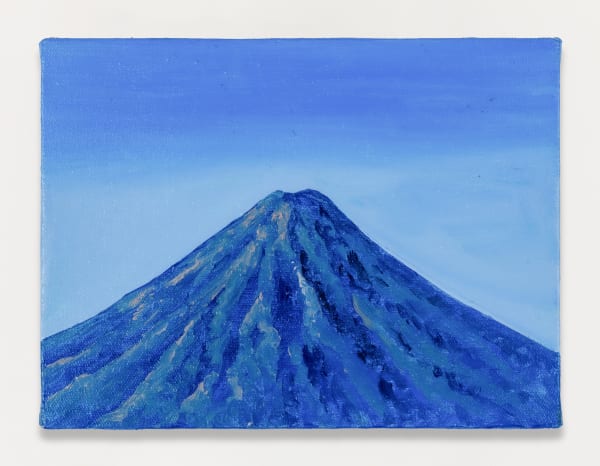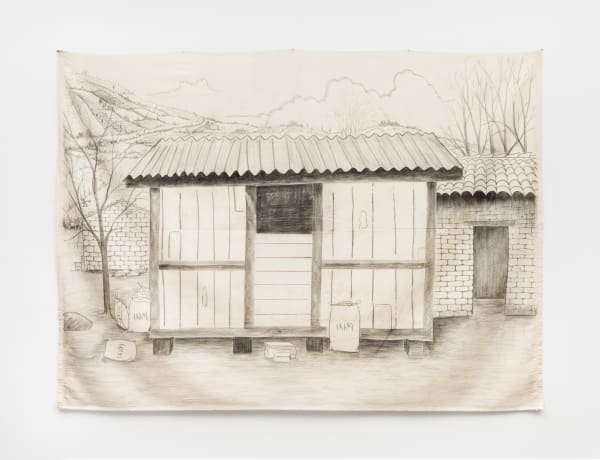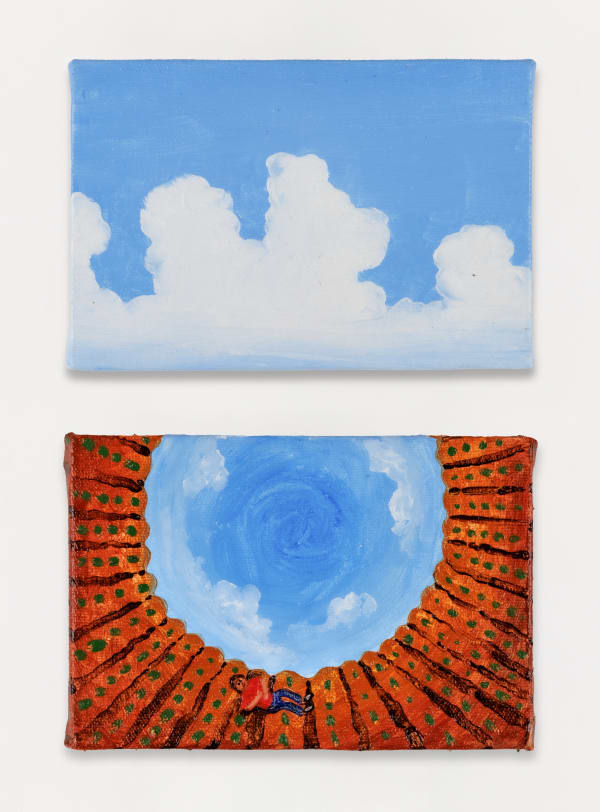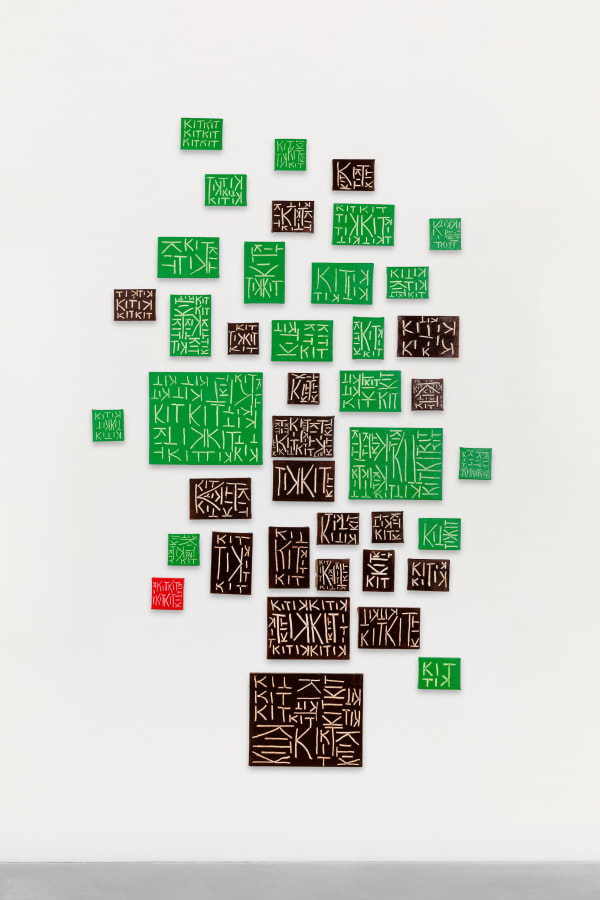Kutenten - kutenten - kutenten Edgar Calel
Calel’s works are often grounded in attentive relationships with the earth, its elements, and animal-vegetal motifs and are known to playfully challenge Western conventions and perspectives of permanence. The artist’s use of the Kaqchikel language, transpositional awareness, and the reflexivity of his presence in the places he travels belong to a practice celebratory of the daily role of spirituality among his people and vigilant toward daily threats of exclusion and cultural erasure, particularly in relation to the violence and aftermath of the Guatemalan Civil War.
Kit Kit K’o Jay [kit kit hay casa] (2024), a work centered around the exhibition’s motifs of sound and community reverberates “a sonoric gesture and translation, a gesture of feeding birds.” The gesture Calel references is the “kit kit ” birdcall the artist’s grandmother used to make, which Calel interprets in his art as resonating throughout the community. This bond is further present in the expressively depicted human figure in Kit Kit Che [kit kit arbol] (2024) formed entirely of boxes of script depicting the kit kit call, emphasizing the indivisibility of community among his people.
Q’ojom Ab’ej [musica de piedra] (2024) emphasizes movement and vibrations within rocks, symbolizing the presence of spirits that enter and leave, with fire offerings made for them. The artist’s family, who engage in traditional candle-making, are key to understanding the intimacy of the work’s representation of candles and fire, whose different iterations and offerings highlight sonoric and spiritual properties and vibrations. Created with charcoal on unbleached canvas, the importance of this work is underscored by its depiction of ceremonial offerings to ancestors, as is customary in Kaqchikel Maya spiritual practice. This piece’s emphasis on animism and ceremony also relates to agricultural labor and prayer for a bountiful growing season.
Tikonel [sembradores] (2024) touches on the significance of agriculture and the harvest prayer, specifically corn and corn banks for the Maya-Kaqchikel people. The work’s depiction of sowers in the field highlights the importance of agricultural labor in the artist’s local culture, reflecting, alongside other works in the same series, the community’s deep connection to the land and the cyclical nature of growth and sustenance in relation to “a historical base of memories of many generations,” autonomy, and planning for the future.
Transitioning to more personal and familial themes, Tuktukikit (2024) depicts an image of the artist’s family in a forest. Created with charcoal on unbleached canvas, a tuk-tuk, a small motor car, represents the transport of people and information, also contemplating the role of art in cultural transmission.
Further exploring personal narratives, Juxuj Panu Béy [trazos en mi camino] (2024) presents a self-portrait where Calel’s family watches him walk away, symbolizing the broad journey of an artist and Calel’s role as a cultural ambassador. The surrounding scribbles represent everything around him, with life and work connecting points within these scribbles to find a path. The artist depicts himself as a wanderer, wearing a jaguar hide, a recurring motif in his art that symbolizes strength and connection to his heritage, strength, and spirituality. This portrayal emphasizes Calel’s role in navigating between worlds, bridging his cultural roots with broader artistic expressions. Also engaging on a path of reflexivity, Retain Balalh [el peso de mi ser] (2024), a sculptural work, explores the concept of one’s being and its impact on the present and future, featuring an imprint of the artist’s foot inside. A candle placed inside the print emphasizes the importance of fire, signifying a connection between human beings and the land. This work, like others, emphasizes the significance of familial and communal connections while accenting the solitude of the artist’s path and its impact on the heritages he represents.
Calel’s major solo exhibitions include Kaqchikitkit pa Copán, Desanexo do Desapê, Brazil B’alab’aj (Jaguar Stone), Sculpture Center, New York, NY, USA (2023); Pa ru tun che´(From the Treetop), Proyectos Ultravioleta, Guatemala City, Guatemala (2021). His group exhibitions include Aventar la piedra y enseñar la mano, Armada Galería, Mexico City, Mexico (2024); En la casa de mi hermano (At My Brother’s House), Proyectos Ultravioleta, Guatemala City, Guatemala (2023); Choreographies of the Impossible, 35th São Paulo Biennial, São Paulo, Brazil (2023); B´ey, Galeria de artistas, São Paulo, Brazil (2023); Plural Perspectives, Soft Power, Berlin, Germany (2023); uMoya: The Sacred Return of Lost Things, 12th Liverpool Biennial, Liverpool, UK (2023); Soft and Weak Like Water, 14th Gwangju Biennale, Gwangju, South Korea (2023); El suceso es en la Casa de Hierro, a la par de las Estrellas, enfrente de la Playa, del otro lado del Chino Pobre (The Event Is at the Iron House, Next to the Stars, in Front of The Beach, on the Other Side of the Poor Chinese), Casa de Hierro, Guatemala City, Guatemala (2023); The Night Dies by the Day, the Day Dies by the Night, Proyectos Ultravioleta, Guatemala City, Guatemala (2023); A Parábola do Progresso, Sesc Pompéia, São Paulo, Brazil (2022); Brazil Is It Morning for You Yet?, 58th Carnegie International, Pittsburgh (2022); 11th Berlin Biennale, Berlin, Germany (2020), among others.
Collections that house Calel’s work include Tate, London, UK; Rijkscolectie – National Collection of the Netherlands, Amersfoort; Museo Nacional Centro de Arte Reina Sofía, Madrid, Spain; National Gallery of Canada, Ottawa, Canada; Fundación TEOR/ética, San José, Costa Rica; MADC Museum of Contemporary Art and Design, San José, Costa Rica; Kadist Foundation, San Francisco, CA, USA; Hammer Museum, Los Angeles, CA, USA; and Carnegie Museum of Art, Pittsburgh, PA, USA.
-
 Edgar Calel, Tikonel (sembradores), 2024
Edgar Calel, Tikonel (sembradores), 2024 -
 Edgar Calel, Volcan (volcan), 2024
Edgar Calel, Volcan (volcan), 2024 -
 Edgar Calel, Ru Chi Juyu (labios del bosque), 2024
Edgar Calel, Ru Chi Juyu (labios del bosque), 2024 -
 Edgar Calel, Rua Wachoch (rostro de mi casa), 2024
Edgar Calel, Rua Wachoch (rostro de mi casa), 2024 -
 Edgar Calel, Ru Tzubial Jun Xar Paruwi Qa Tikon (mirada de un pajaro sobre nuestra siembra), 2024
Edgar Calel, Ru Tzubial Jun Xar Paruwi Qa Tikon (mirada de un pajaro sobre nuestra siembra), 2024 -
 Edgar Calel, Ru Setelen Ri Kechelaj (la redondez del bosque), 2024
Edgar Calel, Ru Setelen Ri Kechelaj (la redondez del bosque), 2024 -
 Edgar Calel, Tuktukitkit, 2024
Edgar Calel, Tuktukitkit, 2024 -
 Edgar Calel, Juxuj Panu Béy (trazos en mi camino), 2024
Edgar Calel, Juxuj Panu Béy (trazos en mi camino), 2024 -
 Edgar Calel, Q'ojom Ab'ej (musica de piedra), 2024
Edgar Calel, Q'ojom Ab'ej (musica de piedra), 2024 -
 Edgar Calel, K'o Jay Kit Kit (hay casa kit kit), 2024
Edgar Calel, K'o Jay Kit Kit (hay casa kit kit), 2024 -
 Edgar Calel, Retain Balalh (el peso de mi ser), 2024
Edgar Calel, Retain Balalh (el peso de mi ser), 2024 -
 Edgar Calel, Mama' Uxlanik (gran descanso), 2024
Edgar Calel, Mama' Uxlanik (gran descanso), 2024 -
 Edgar Calel, Ru Mujb'al Nu Tz'ub'al #3 (sombra para mis ojos #3), 2024
Edgar Calel, Ru Mujb'al Nu Tz'ub'al #3 (sombra para mis ojos #3), 2024 -
 Edgar Calel, Ru Mujb'al Nu Tz'ub'al #2 (sombra para mis ojos #2), 2024
Edgar Calel, Ru Mujb'al Nu Tz'ub'al #2 (sombra para mis ojos #2), 2024 -
 Edgar Calel, Awan Achik' (sueño de maîz), 2024
Edgar Calel, Awan Achik' (sueño de maîz), 2024 -
 Edgar Calel, Ru Chi Juyo (portales del cerro), 2024
Edgar Calel, Ru Chi Juyo (portales del cerro), 2024 -
 Edgar Calel, Kit Kit Che (kit kit arbol), 2024
Edgar Calel, Kit Kit Che (kit kit arbol), 2024

